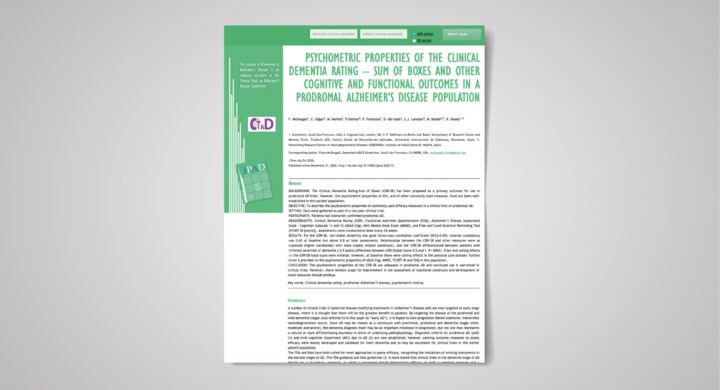Contributors:
Kaycee Sink, MD, MAS (Chief Medical Officer)
Svenja Wacker, PhD (Neuropsychology Science Director)
Developed in 1982 at the Washington University School of Medicine, the Clinical Dementia Rating (CDR) is a commonly used endpoint assessment tool in Alzheimer’s disease (AD) clinical trials that measures the severity and progression of dementia in both symptomatic and preclinical AD.
Through in-depth, semi-structured clinical interviews with the participant and an informant, such as a caregiver, spouse, or other close family member, the rater determines disease severity on a 5-point scale across six domains: memory, orientation, judgment and problem-solving, community affairs, home and hobbies, and personal care. Then, individual ratings are synthesized into one global CDR score.
Unlike norm-based psychometric measures which compare individual functioning to a reference group, the CDR measures intra-individual change from pre-dementia baseline (Galvin, 2009), which is critical for tracking change over time or assessing treatment impact.
Informed by extensive experience designing and running global Alzheimer’s disease clinical trials, Cogstate scientific leaders explore the CDR’s advantages, limitations, and considerations for effective use.
Key Advantages of the CDR for Alzheimer’s Disease Trials
“The CDR has been extensively validated for use in AD clinical trials and provides good inter-rater reliability,” said Wacker, “facilitating comparisons across studies and populations. In addition, its flexible interview format makes the CDR adaptable for remote administration.”
Other advantages of the CDR include its sensitivity for disease staging and detection of disease progression. The CDR combines both functional ability in daily life and cognitive performance, offering a more holistic view as compared with psychometric tests alone.
The CDR has a standardized semi-structured interview format that allows for consistent administration across different studies, sites, and raters. It can also be used repeatedly without significant practice effects, making it useful for monitoring disease progression and the impact of investigational drugs.
Challenges and Considerations When Using the CDR in Alzheimer’s Disease Trials
Despite its advantages, the CDR is not without challenges that may impact consistency and feasibility across diverse study settings.
The assessment is extremely complex due to the clinical interview format. This means trial teams must have access to highly skilled clinicians as raters. The quality of the interview and the clinician’s ability to solicit comprehensive and valid information will make or break the effectiveness of using the CDR as an endpoint.
“CDR raters must have a deep understanding of Alzheimer’s disease and strong clinical interviewing skills,” said Wacker. “Training programs for CDR raters should include extensive calibration, including reviewing didactic material on the scale, completion of the Washington University training program, and ideally demonstrating mastery of administration skills via a supervised practice session where feedback can be provided.”
In addition to the complexity, the CDR by its nature is subjective, with different clinicians potentially assigning different scores to the same set of information. The informants’ subjective reporting of the participants’ functioning can also impact reliability. Thus, any changes in informants or clinicians over the course of a trial can induce significant variability.
Complexity and subjectivity are not the only challenges faced. The CDR can layer in high rater and patient burden as the administration can take up to 60 minutes to complete. Furthermore, the CDR is not suitable for screening, due to its length and complexity.
Utilizing the CDR in Alzheimer’s Disease Trials
The CDR remains a cornerstone in dementia research due to its extensive validation, sensitivity, semi-structured format, repeatability, and favorability for remote administration. However, integrating the CDR into a trial protocol demands careful planning, particularly around selecting experienced clinicians, ensuring consistency and objectivity in both the interviewer and informant, and managing potential site burden.
- This blog is part of a series exploring the individual scales reviewed in our Alzheimer’s Disease Clinical Trial Endpoint Guide. Access the full guide here.
- Interested in learning more? We are happy to discuss endpoint selection with your team in more depth. Contact us today.
Sources




To overcome data quality concerns, sponsors may consider adopting central rating services as a solution to increase the reliability, standardization, and scoring accuracy of CDR data. With central rating, outcome measures are remotely administered by an independent team of highly qualified raters, allowing for enhanced data quality, reduced rater and participant burden, rapid site readiness, and optimized recruitment and retention.